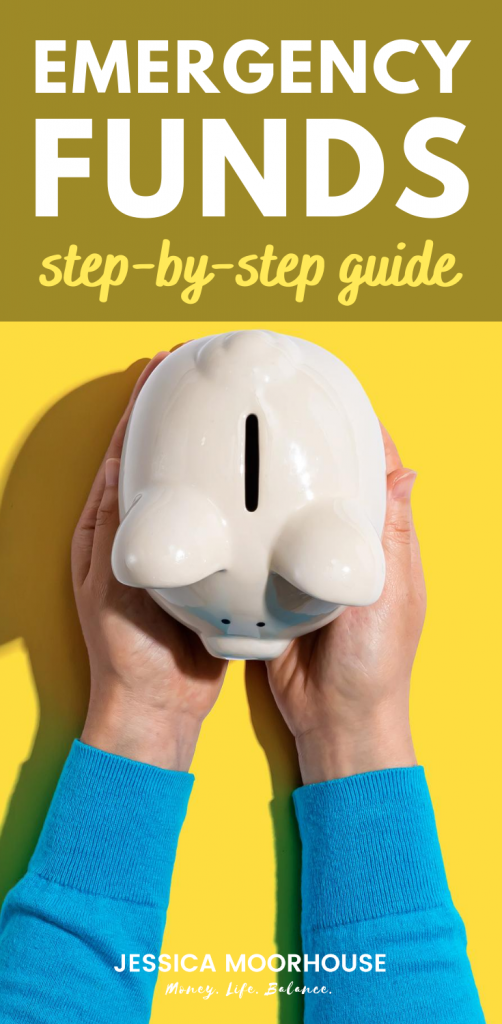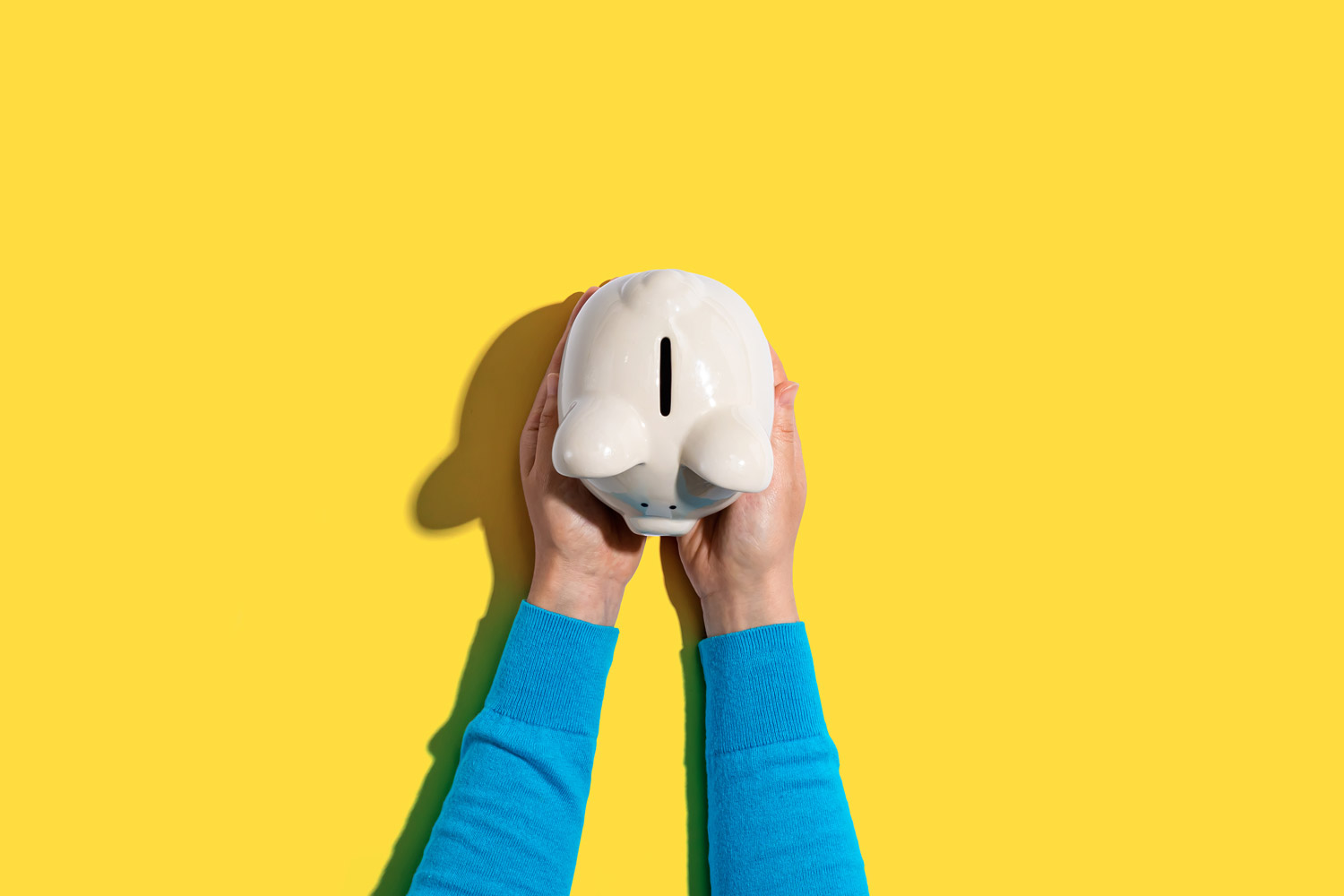[I talk about emergency funds…A LOT. To my course students, my financial counseling clients, and my podcast guests. And yet, surprisingly, I don’t have a blog post about them.

To be fair, I’ve been blogging for close to 9 years now. At some point, I probably did have a post on emergency funds. But as you may notice going through my archives, I’ve deleted probably 90% of my old blog posts. Trust me, it was for the best. I’m a much better writer now, with way more experience (heyo, Accredited Financial Counsellor Canada® over here!).
With all that said, and since I realized I also didn’t have a YouTube video on the topic, here is my blog post on emergency funds!
What Are Emergency Funds for?
Let’s start with the basics. What are emergency funds for exactly? As the name might suggest, an emergency fund is meant to pay for financial emergencies. What kind of emergencies, you ask?
Here are some emergency examples:
- Medical emergency
- Car breaks down or car accident
- Home repairs (i.e. furnace breaks down, pipes burst, roof leaks, etc…)
- Vet bills
- Job loss
- Someone close to you dies and you need to book a flight to the funeral (this happened to me!)
- Someone close to you needs assistance and you need to take time off work to help
Basically, an emergency fund should be used for an emergency that can’t be completely paid for with insurance or is something you can’t predict. In other words, it’s to pay for an urgent need.
With that said, you should not use an emergency fund for things that aren’t emergencies or needs. Going on a trip because you haven’t been anywhere for a while isn’t an emergency. Going on a shopping spree because you’ve had a rough month and want to treat yourself isn’t an emergency. Paying for things that you could have saved for in advance but just didn’t…well that’s what a sinking fund is for.
What Is a Sinking Fund?
To be technical, a sinking fund is an amount of money set aside by a corporation or government to ensure they can pay back the bonds they issue to investors. I’m not going to get into bonds here (save that for a future post!), but I thought I’d mention it since that is where the term originated.
In the personal finance world, the term sinking fund is used to describe savings accounts meant for planned spending.
For example, if you set up a savings account dedicated to saving up for a vacation and another savings account set up to save money in advance to pay your property taxes, those would be considered sinking funds.
I personally don’t call them this, I just call them savings goals or savings goal spending, but it honestly doesn’t matter what you call them. The important thing is to have them. Having sinking funds is a key way to stay on top of your future expenses so you aren’t forced to dip into your emergency fund when it’s not really an emergency fund.
How Much Should I Save Up?
The rule of thumb that you’ll hear over and over is to have 3 to 6 months’ worth of your living expenses saved up for your emergency fund. If you have a fairly stable job, 3 months should be fine. If your job isn’t as stable, consider saving 6 months. But here’s the thing…this is just a rule of thumb! Save up whatever amount you want that makes you feel safe! For me in my 20s, it was $10,000. Now that I’m in my 30s with more financial obligations, I have closer to 12 months saved up.
One thing I want to make crystal clear though, $1,000 is not enough. There are some money experts out there I’ve heard saying this should be enough, but I don’t know where they got that number from. If this pandemic has proven anything, it’s that $1,000 won’t go very far if you lose your job and can’t find work for an extended period of time.
Where Should I Put My Emergency Fund?
This is easy…put it in a high-interest savings account. That’s it. I’ve seen some advice that putting it into a cashable GIC (or CD if you’re in the U.S.) is a fine place to park your emergency fund, but I would beg to differ. You see, although these types of securities are considered fairly liquid, typically you can’t cash them out for 30 days (or longer). This means that if your emergency happens within that window, you can’t access that cash, well, I guess you’re using credit.
Another thing I’d strongly warn against is keeping your emergency fund in cash. Like keeping physical bills someplace in your home. Not only is there the risk that you’ll lose it, it’ll get stolen, or get damaged. But when you hold onto a big amount of cash, that money loses value every day because it’s not earning interest. If it’s not earning interest, it’s not keeping pace with inflation. If it’s not keeping pace with inflation, it will progressively lose its purchasing power.
Should I Be Worried About Cash Drag?
I want to mention cash drag because I’ve heard it used as an excuse for not having an emergency fund. Similar to sinking funds, the term cash drag is actually used in investing. Cash drag refers to the cash part of your investment portfolio used to pay fees or for rebalancing.
The downside of having cash in your portfolio is it isn’t earning the returns your investments are. In an ideal scenario, your entire portfolio would be invested to maximize your returns. But for most portfolios, that’s not possible.
With this in mind, some people believe that it’s pointless to have $10,000+ sitting in a savings account earning minimal interest when they could be earning higher returns by investing that cash instead.
In theory, that sounds great. But in reality, emergency funds are necessary. Just ask anyone who has had a real-life emergency and thank their emergency fund for being their saving grace. The alternative to not holding an emergency fund would be to liquidate your investments (erasing potential future growth) or use credit (charging you interest).
Can’t I Just Use My Line of Credit for My Emergency Fund?
Another thing I want to debunk is the belief that a line of credit is an acceptable replacement for an emergency fund. Sorry, but no. There’s nothing wrong with having a line of credit, however, it’s not a replacement for an emergency fund. Instead, it should be used in conjunction with an emergency fund.
For example, let’s say you have your emergency fund with EQ Bank so you can earn high interest on your money. A downside of having your money there is it can take up to 5 business days to withdraw funds. If an emergency happens, you need cash fast. That means you’d likely have to use credit while you wait for your funds to come through. A line of credit would be helpful in this situation since it charges much lower interest than credit cards.
But, you’re still borrowing money and need to pay it back. Luckily, you’ve got an emergency fund and can simply transfer funds from EQ Bank straight onto your line of credit. This would help you avoid getting into debt, and you’d only have to pay minimal interest for the few days you borrowed from your line of credit.
How Do You Build an Emergency Fund?
The last thing you should know is how to start building an emergency fund. Similar to saving up for other savings goals, you’ve got 4 options:
- Cut back on your spending to free up more cash
- Earn more money through a side hustle
- Save up any extra money that comes your way (i.e. tax refund, bonus, inheritance, etc…)
- All of the above
And that’s it! Emergency funds really aren’t that complicated. It’s just a savings account with cash in it that you don’t touch unless there’s an emergency. But they are incredibly important to have. Especially during these uncertain times we now live in.
If this pandemic has proven anything, it’s that emergency funds are essential. If you don’t already have one, take this as a sign that it should be your #1 priority moving forward.
Got any questions I didn’t answer about emergency funds? Let me know in the comments below!

I’m missing something, why would you use a credit line that charges you interest to cover the five day transaction time in your example instead of a credit card. Credit cards charge zero interest as long as you pay them in full. Is it because some emergencies can’t be handled with credit cards?
That’s a very good point Steve so thanks for the comment! I was more trying to explain how you could use a LOC in combination with an emergency fund if you wanted to, though like you mentioned, depending on the size of the emergency, you may want to put it on your credit card then pay off the balance with your emergency fund money. However, here are a few scenarios in which it would make more sense to use a LOC instead of a credit card. You may have a very small credit card limit that’s not enough to cover your emergency expense. You may already have a high balance on your credit card and putting another expense on it would bump up your credit utilization thus negatively affecting your credit score. You may be on a debt repayment plan in which you don’t want to put any new charges on your credit card. You may not have a credit card at all. And lastly, because you have a low interest rate on your LOC compared to your credit card, and you’ve battled with debt in the past, it makes you feel more comfortable putting it on your LOC instead of your credit card. Thanks for reading and commenting! 🙂